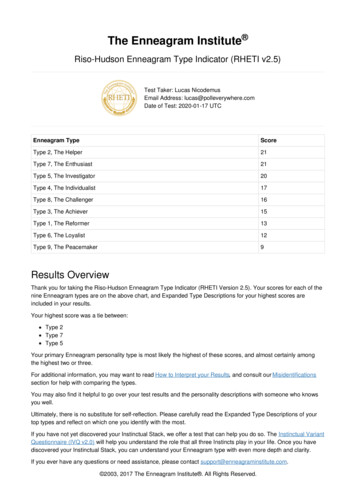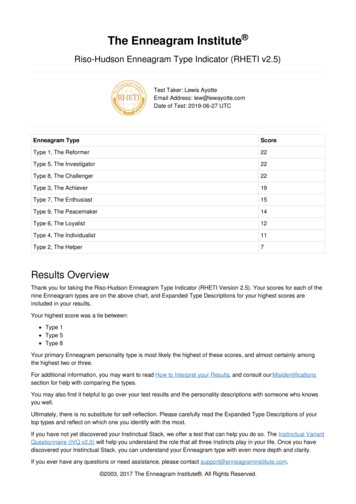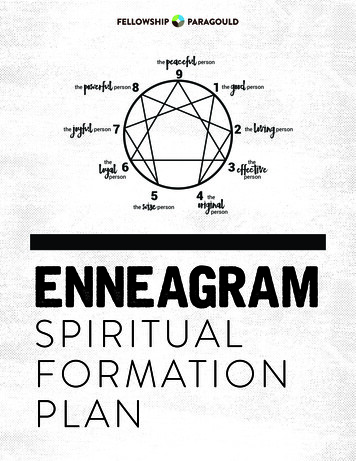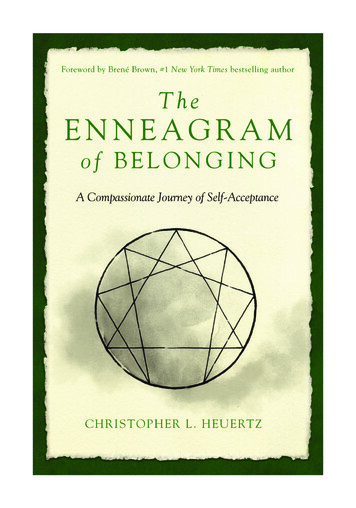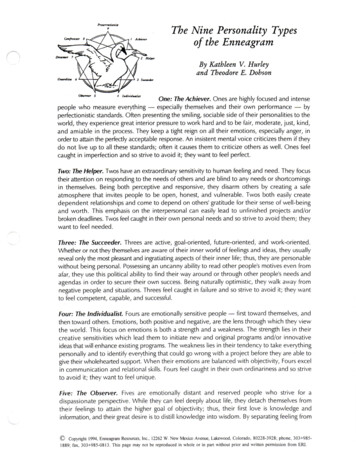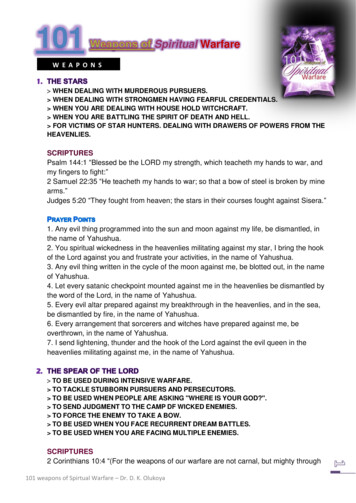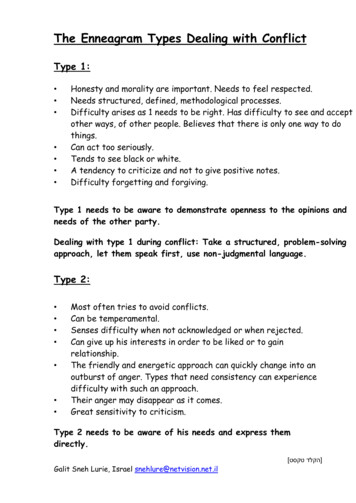
Transcription
The Enneagram Types Dealing with ConflictType 1: Honesty and morality are important. Needs to feel respected.Needs structured, defined, methodological processes.Difficulty arises as 1 needs to be right. Has difficulty to see and acceptother ways, of other people. Believes that there is only one way to dothings.Can act too seriously.Tends to see black or white.A tendency to criticize and not to give positive notes.Difficulty forgetting and forgiving.Type 1 needs to be aware to demonstrate openness to the opinions andneeds of the other party.Dealing with type 1 during conflict: Take a structured, problem-solvingapproach, let them speak first, use non-judgmental language.Type 2: Most often tries to avoid conflicts.Can be temperamental.Senses difficulty when not acknowledged or when rejected.Can give up his interests in order to be liked or to gainrelationship.The friendly and energetic approach can quickly change into anoutburst of anger. Types that need consistency can experiencedifficulty with such an approach.Their anger may disappear as it comes.Great sensitivity to criticism.Type 2 needs to be aware of his needs and express themdirectly.] [הקלד טקסט Galit Sneh Lurie, Israel snehlure@netvision.net.il
Dealing with type 2 during conflict: let them expressthemselves, ask clarifying questions, share your position, confirmtheir position, discuss feelings and thoughts.Type 3: Conflicts due to delays and due to fear of failure. Focus onefficiency and goal achievement. Sense of impatience, quick talk, business oriented. Don’t like to involve emotions - prefer to focus "on thematter". Flexible - ability to adjust positions and solutions quickly. Sensitive to their image and to criticism. Important to define achievements, goals and success.Type 3 needs to be aware of: aspects related to emotions andto relationships as well as his tendency to be sensitive to hisimage.Dealing with type 3 during conflict: Be kind and clear, avoidusing emotional and negative tones.Type 4:Communication style- promotes closeness and then pulls apart.Dislikes routine.Attacks competitors.Needs unilateral support from others against the counterpartyor against people whose opinion is different. Needs approval to strengthen self-image. Gets hurt easily. Can be condescending, angry, sarcastic and may over-react. ] [הקלד טקסט Galit Sneh Lurie, Israel snehlure@netvision.net.il
Type 4 needs to be aware of: the tendency to overrate theimportance of feelings . Needs balance by objective thinking.Dealing with type 4 in time of conflict: Allow an open discussionabout feelings, be attentive, don’t tell him he’s too sensitive,don’t blame.Type 5: Tries to avoid conflicts and direct confrontation. Keeps Emotional Distance. This contributes to the ability tonegotiate carefully even in stressful situations, but it canalso cause frustration for people who need to express theirfeelings. Gives as little information as possible. Can seem agreeing while he truly is not. Has creative thinking ability to solve problems. Able toswitch between alternatives without emotional attachment. Personal decision making process. Notifies about his finaldecision.Type 5 needs to allow room for emotions .Dealing with type 5 during conflict: Inform, in advance, yourwillingness to meet and talk and state the topic. Set a timeframe for the meeting. Try to discuss the problem rationally,try to minimize emotional expressions.Type 6: Has very good problem-solving abilities. Tends to question the other party's intentions no matter howpositive they are. Has trouble trusting.] [הקלד טקסט Galit Sneh Lurie, Israel snehlure@netvision.net.il
Asks the "tough questions" even if there is a positiveatmosphere. Has difficulty with authority. Can be a potential for conflict. Tends to give too much voice to risks. Pessimistic aboutoutcomes. Needs honesty and openness (this helps him contain hisconcerns). May attack sharply when offended or felt attacked. Has a tendency to reject things.Type 6 needs to be aware of his tendency to attribute negativeintentions to others. Clarify before building an opinion andattacking.Dealing with type 6 in conflict: Build trust by consistency,honesty and trustworthiness. Let them express themselves.Acknowledge their right to think as they think. Show theintention of resolving things in a positive way. Be warm andgenuine.Type 7: Prefers to avoid direct confrontation. Optimistic. Has a good ability to raise diverse options for conflictresolution. Fear of interactions that might hurt his positive self-image. Difficulty with restrictions. Impatience for details. Can be self-centered. Has a tendency to deny difficulties. Can treat authorities as equal which may provoke conflict. Conflict can arise around his exaggerated promises. Can act without thinking beforehand about the details.] [הקלד טקסט Galit Sneh Lurie, Israel snehlure@netvision.net.il
Type 7 needs to be aware of the need to recruit the ability todeal with the pain and the difficult parts of conflict withoutescaping.Dealing with type 7 during conflict: Ask open and non-judgmentalquestions, allow free and full expression, help him define hisarguments. Avoid accusations and criticism.Type 8: Feels comfortable with conflicts. Confronts in order to win.Compromise is seen as submission. May exacerbate thereaction when others expect a compromise. Expresses anger openly and freely (difficult for others thathave difficulty with direct confrontation). Likes elusive and direct communication styles. Works forclarity. Has difficulty exposing softer sides. Black or whiteperception. Great sensitivity to dishonesty and unfairness. Can attack personally and not be sensitive to vulnerability. Believes his truth is the absolute truth. Invests energy toinfluence. Has a tendency to criticize.Type 8 needs to allow sensitivity to the sensitive and vulnerablesides of himself and of the other party.Dealing with Type 8 in conflict: Be direct, be patient with theirfeelings even if they sound intense to you, act assertively butavoid the aggravation of the tones, avoid accusations. Stress hisresponsibility towards others.] [הקלד טקסט Galit Sneh Lurie, Israel snehlure@netvision.net.il
Type 9 Conflict avoider. Sees a variety of alternatives and understands differentopinions even if they contradict his position. At first it is difficult to know where they stand – they willlook ambivalent. Later, the conflict style seems sometimespassive-aggressive as they slow down and answer only what isnecessary. Tends to delay decision-making. Long thought process. May pass a controversial statement by email to avoid directconfrontation (sometimes aggravating others even more). They hope that by not saying "no" they will avoid conflict butothers may feel ignored and manipulated and may developanger. Others feel they are being pushed to take the aggressive role.9 needs to be aware of giving a clear definition of their needsand positions as well as their negative feelings.Dealing with 9 in conflict: Avoid direct pressure, ask questionskindly, listen patiently, it may take him time to express himselfand decide, suggest alternatives while considering his feelings.] [הקלד טקסט Galit Sneh Lurie, Israel snehlure@netvision.net.il
The Enneagram Types Dealing with Conflict Type 1: Honesty and morality are important. Needs to feel respected. Needs structured, defined, methodological processes. Difficulty arises as 1 needs to be right. Has difficulty to see and accept other ways, of other
